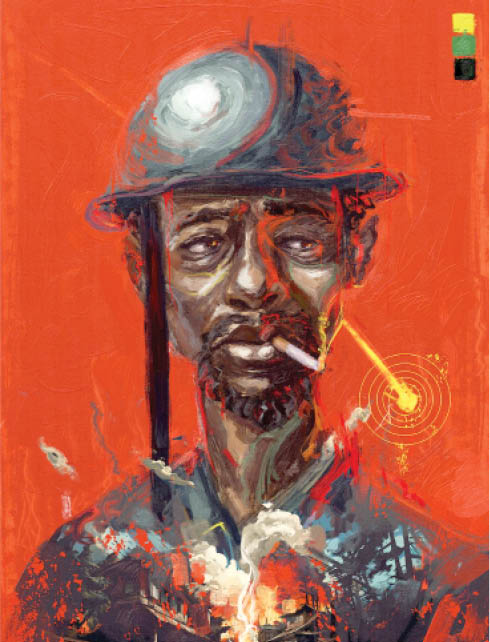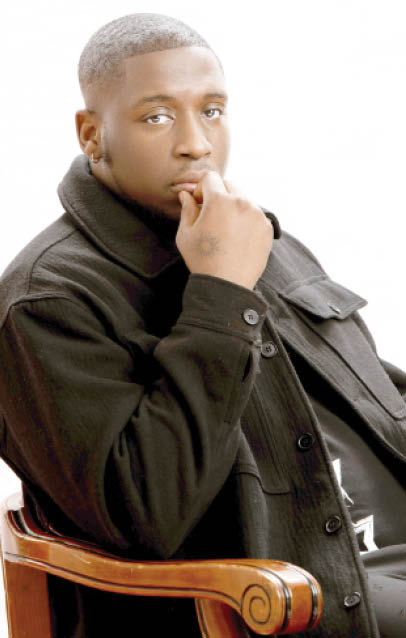Anthony Azekwoh is a Lagos-based contemporary artist and author. His art focuses on African folklore and literature, which he uses to create stories about his homeland, transformation, and evolution. In this interview with Daily Trust on Sunday, Azekwoh gives an insight into his life as an artist and his experiences so far.
Can you describe your journey as a digital artist and how you got started in this field?
I started painting in 2016, after my laptop broke and I needed to express myself creatively. From experimenting with pens on A4 paper to stealing my sister’s mouse and using that to draw on my laptop, I taught myself how to draw with a mouse and that led to some of my work being noticed online which led to people paying me to do work. And somehow, that all snowballed into this.
What inspired you to become a digital artist, and what keeps you motivated to create?
I’m a stubborn and restless person and I need to keep myself active. That buzz, for me, is why I create: I can’t do anything else.
Could you share some of your favourite digital art projects or pieces you’ve worked on, and what makes them special to you?
I would say my current project “There is a Country”, is my favourite, mostly because of the subject matter and how it reflects what I’m thinking about regarding our country as a whole.

What software and hardware do you primarily use for your digital art, and why do you prefer them?
Photoshop is my primary software and I use it mainly because it’s a huge powerhouse for everything you’d need as an artist.
How do you approach the creative process when starting a new project?
It’s a very dynamic process but the main thing is that I allow myself to be open and consider the best way to approach a project in a way that’s new, fresh and entertaining.
Can you explain your workflow from concept to final rendering, including any specific techniques or tools you use?
My creative journey commences with a conceptual phase, often drawing from the rich tapestry of African folklore and mythology. Once a concept resonates, I transition into the sketching phase using traditional mediums like ink pens on paper initially. However, the core of my digital artwork takes form through Adobe Photoshop, where I meticulously render each piece until it aligns with what I imagined.
What types of digital art do you specialise in (e.g., illustration, concept art, 3D modelling), and do you have a favourite style or genre?
I’m really into digital painting and illustration as well as 3D sculpting. I don’t have a favourite style per say, they all have their own versions of me that I imprint on them.
How do you handle creative blocks or moments of frustration during a project, and what strategies do you use to overcome them?
Creative blocks are an inevitable part of the artistic process. Whenever I encounter such moments, I often step back to gain fresh perspectives or delve into other creative or intellectual pursuits. This reinvigorates my thought process and often leads to newfound inspiration.
Collaboration is often a part of the creative process. Can you share your experience working with other artists or clients on collaborative projects?
I’ve had the privilege of working with prominent artistes like Simi, Adekunle Gold, Masego, Blaqbonez, and Show Dem Camp on cover art projects. These collaborative endeavours not only broaden my creative horizon but also foster a rich exchange of ideas and styles.
What role does storytelling play in your digital art, and how do you convey narratives through your work?
Storytelling is the essence of my digital art. It’s the vehicle through which I navigate the realms of African heritage and contemporary narratives, endeavouring to evoke a sense of connection and reflection in the audience.
Can you discuss the importance of composition and colour theory in your digital art, and how do you make deliberate choices in these areas?
Composition and colour are pivotal in effectively narrating stories through my art. Deliberate choices in these domains guide the viewer’s eye and evoke the intended emotional responses, enriching the overall narrative experience.
What are some of the challenges you face in the digital art industry, and how do you stay updated with the latest trends and techniques?
The digital art landscape is ever-evolving, posing both challenges and opportunities. Staying updated with the latest trends, tools, and technologies is crucial. I’m always searching, trying to find that new wave or pulse that will push things further. I do this by being chronically online, talking to people, and travelling. Anything that can broaden my horizon.
Are there any artists, digital or otherwise, who have had a significant influence on your work? If so, who and why?
Yes, artists like Sam Spratt, Duro Arts, Duks Arts, Renike, Chigozie Obi, are just some of the people who’ve inspired me and the common theme amongst them is that they are honest in how they represent themselves and what they’re thinking.
How do you balance creativity and practicality when working on commercial or client-based projects?
It comes and goes. I feel like I have different phases where, for instance, I’m in one particular mode of mind and then the other months later. I allow my energy and frame of mind judge what space I’m ready for at that given moment.
In the rapidly evolving world of digital art, what are your long-term career goals, and how do you plan to achieve them?
My goals are wide and involve changing the landscape of digital art in Africa. With Lewa Gallery, I hope we can make a difference in how digital art is represented in the mainstream world.
What inspired the theme of your exhibition?
The theme of the exhibition was inspired by Chinua Achebe’s book of a similar title “There was a Country”. There is a Country is my own personal distillation of my experience as a Nigerian man in today’s country.
What feelings did you intend to invoke in your audience?
I wanted them to feel angry yet hopeful and be in awe at the history and culture we still hold.
Which of your works will you say got the most attention from the audience and what’s the story behind it?
I would say that so far “No Victor No Vanquished” is the centrepiece of the exhibition, depicting a scene from the Nigerian Civil War and bringing that feeling of despair and hope as close as it can to the viewer.
